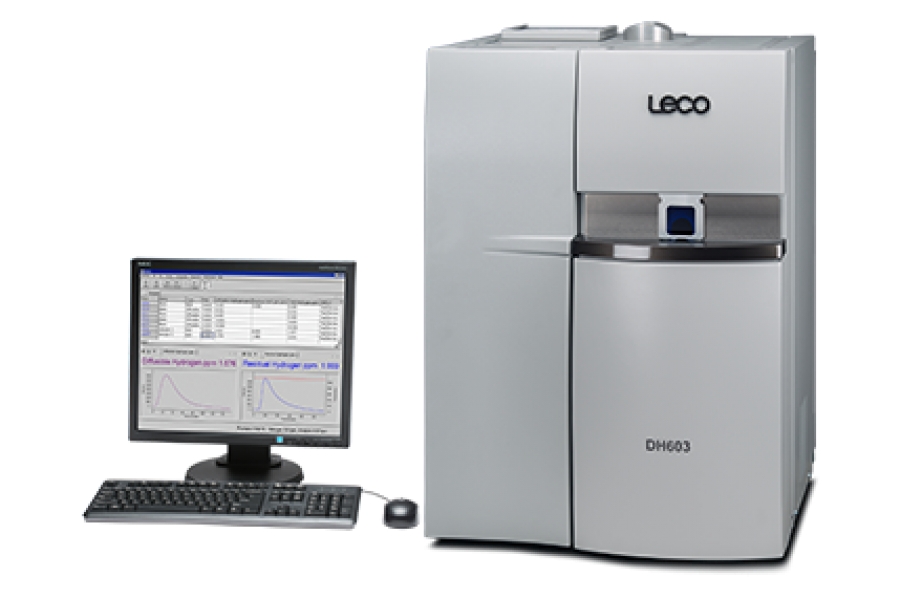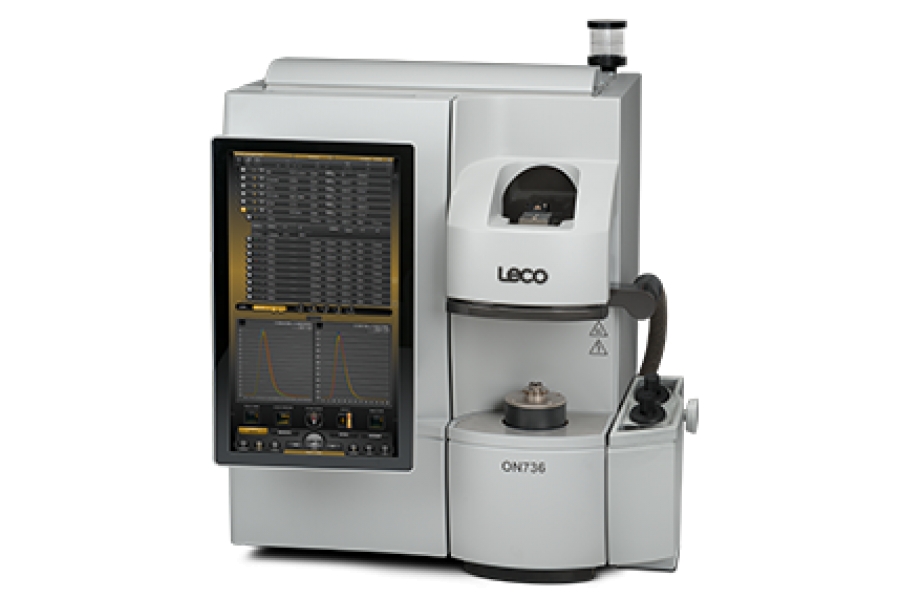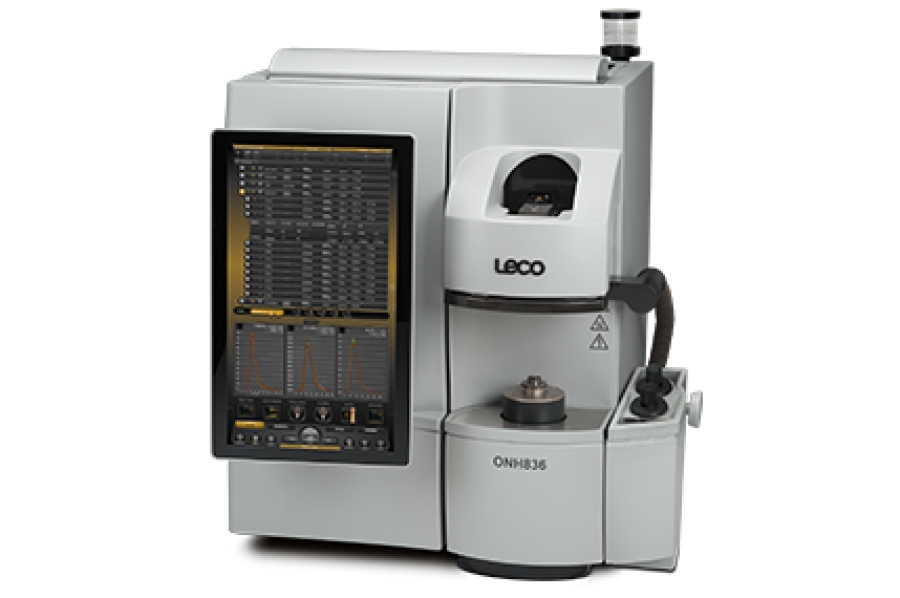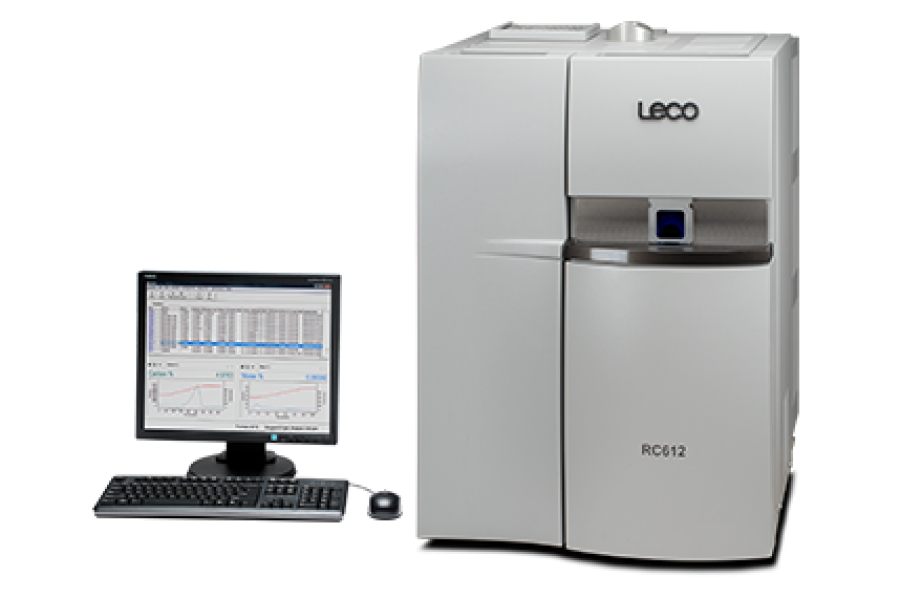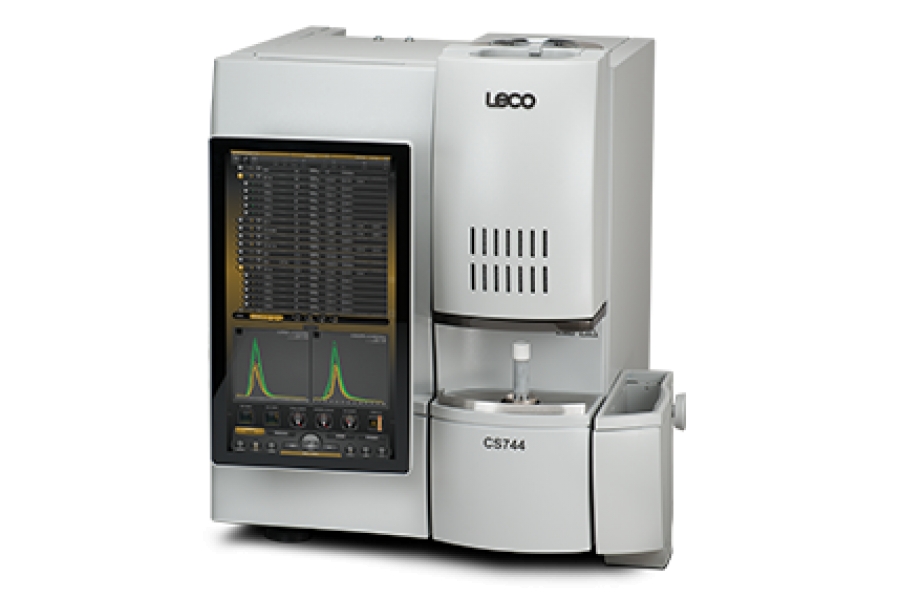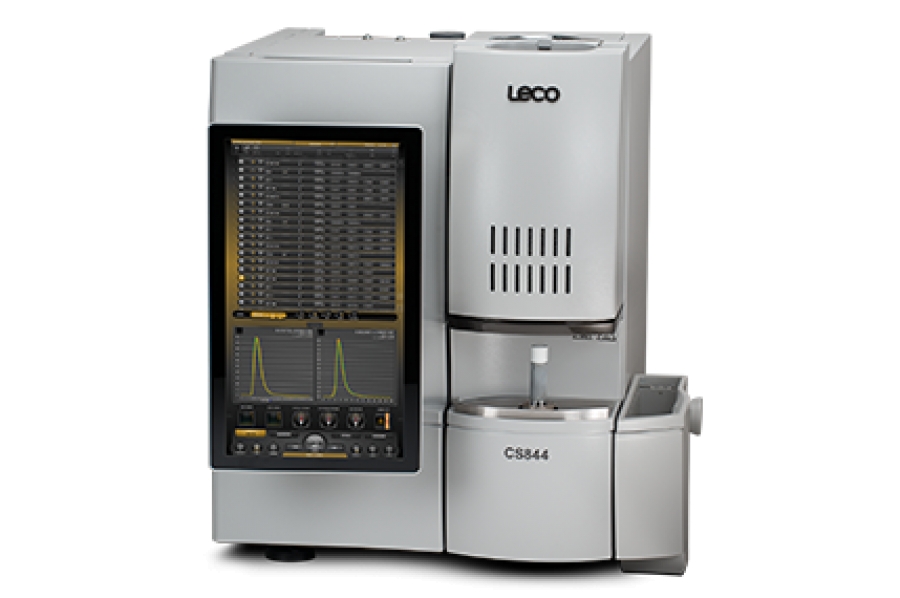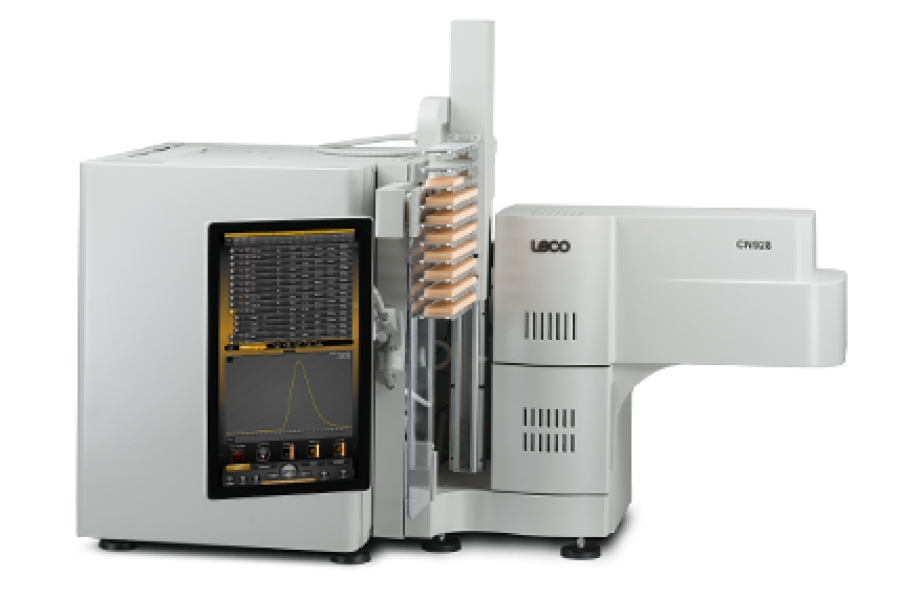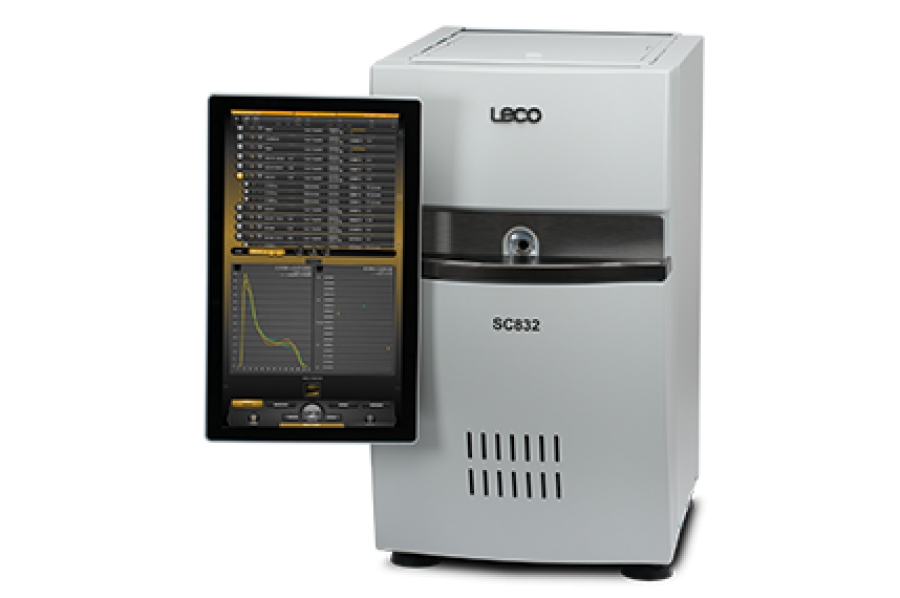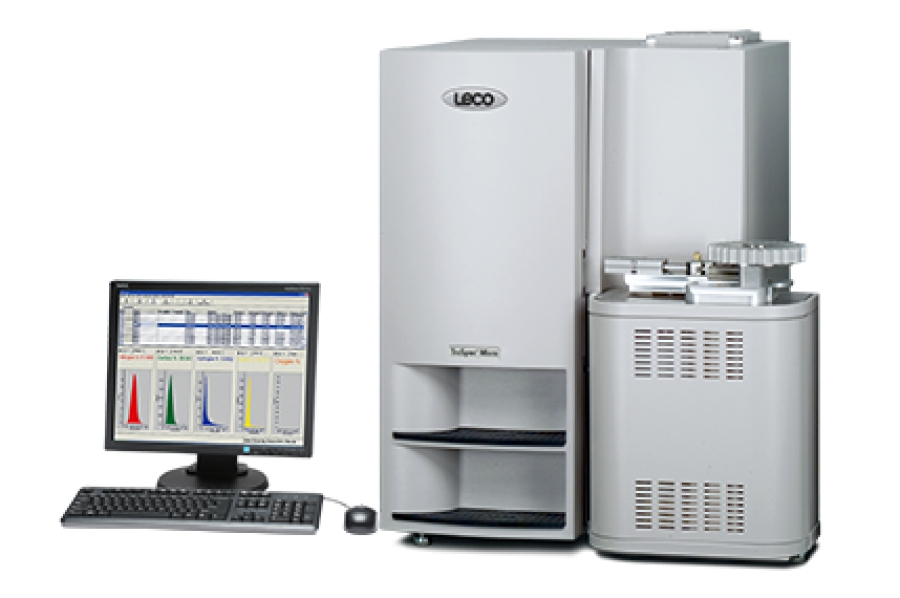
 LECO
Улучшение результатов
LECO
Улучшение результатов
DH603 Hot Extraction
Residual and Diffusible Hydrogen Determination
Your hydrogen determinations in ferrous alloys are delivered quickly and precisely with our DH603 which uses residual, diffusible, and total hydrogen measurements. A small footprint, user-friendly operating software, increased instrument safety, and reliability are all part of the advanced DH603 design to truly streamline your hydrogen determination.
- Exclusive ECLIPSE architecture—a unique design by LECO that improves reliability and serviceability
- A variety of evacuated pin tubes and diffusible samplers for quick and easy hydrogen determination of molten metals
- Improved plumbing offers faster maintenance of flow path
- Easily accessible components to the operator thanks to ergonomic shells
- The state-of-the-art furnace control system allows for temperature ramping from ambient to 1100°C
- Optional diffusible sampler piercer—you have the choice of diffusible, residual/total hydrogen determination
- Gas dose calibration allows for calibration without reference materials
The DH603 determines the amount of residual (total) hydrogen—or diffusible and residual hydrogen with the optional piercer—in iron and ferrous alloys with a single instrument. The determinator features a user- friendly operating system and advanced furnace control.
Residual (total) hydrogen determination involves placing a pre-weighed sample into the furnace, allowing the hydrogen to be evolved by hot extraction into the flowing gas stream. Samples may be collected using a LECO vacuum pin tube or a similar technique. The hydrogen content is measured by a thermal conductivity detector. Final results are displayed in parts-per-million.
Diffusible and residual hydrogen determination involves placing a sampler in the optional piercing unit, which punctures the sampler, allowing the diffused molecular hydrogen to be purged into the carrier gas stream. The hydrogen is measured by a thermal conductivity detector. The sampler is then removed from the piercing unit and the outer shroud is removed, exposing a pin sample for residual hydrogen analysis. The sample is then weighed and placed into the resistance furnace, allowing the residual hydrogen to be introduced into the carrier gas stream by hot extraction. The hydrogen content is measured by a thermal conductivity detector. Final results are displayed in parts-per-million.
DH603 Details
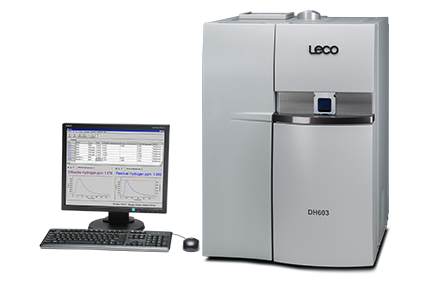
- Models
-
DH603DC with diffusible piercer
-
DH603C
-
- Options
-
Piercer Upgrade Kit
-
Inert Regulator
-
- Featured application
Hydrogen in Steel - Product literature
DH603 - Consumables
736 Series Inert Gas Fusion
Oxygen and Nitrogen by Inert Gas Fusion
Transform your oxygen/nitrogen determination in inorganic materials, ferrous and nonferrous alloys, and refractory materials with our ON736 elemental analyzer. It features an easy-to-use, touchscreen Cornerstone® software, a high-performance detector design, and a number of optional, customizable features to provide the optimal solution for your lab.
- High performance detector design
- Thermostatic construction protects from ambient temperature fluctuations
- Optimized emitter control and detection circuitry
- Choice of either argon and helium carrier gas
- Increase laboratory productivity with automation options
- Available autocleaner minimizes the need for manual cleaning between analysis
- 20-position shuttle loader for both crucibles and samples
- Boom-mounted touch-screen interface provides improved ergonomics and intuitive operation
- State-of-the-art infrared (IR) detection for oxygen determination and thermal conductivity (TC) detection of nitrogen
Applications
The 736 series is ideal for the following applications: inorganic materials, ferrous and nonferrous alloys, copper, aluminum, and refractory materials.
The ON736 Oxygen/Nitrogen system is designed for simultaneous measurement of oxygen and nitrogen content of steel and other inorganic materials. The instrument features custom software designed specifically for
touch operation.
A pre-weighed sample is placed in a graphite crucible which is heated in an impulse furnace to release analyte gases. Oxygen present in the sample reacts with the graphite crucible to form CO and CO2. An inert gas carrier, typically helium, sweeps the liberated gases out of the furnace and through a Mass Flow Controller. The gas then flows through a heated reagent, where the CO is oxidized to form CO2, and H2 is oxidized to form H2O. Oxygen is detected as CO2 using a non-dispersive infrared (NDIR) cell. CO2 and H2O are then scrubbed out of the carrier gas stream. A Thermal Conductivity (TC) detector is used to detect the remaining nitrogen.
The detection system is comprised of both NDIR and TC detectors. NDIR cells are based on the principle that analyte gas molecules absorb infrared (IR) energy at unique wavelengths within the IR spectrum. Incident IR energy at these wavelengths is absorbed as the gases pass through the IR absorption cells. TC detection takes advantage of the difference in thermal conductivity between carrier and analyte gases. Resistive TC filaments are placed in a flowing stream of carrier gas and heated by a bridge circuit. As analyte gas is introduced into the carrier stream, the rate at which heat transfers from the filaments will change producing a measurable deflection in the bridge circuit.
The concentration of an unknown sample is determined relative to calibration standards. To reduce interferences from instrument drift, reference measurements of pure carrier gas are made prior to each analysis.
736 Series Details
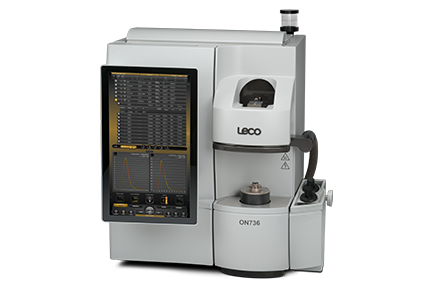
- Models
-
ON736 Oxygen/Nitrogen
-
N736 Nitrogen
-
O736 Oxygen
-
- Options
-
Boom-Mounted Touch-Screen Interface
- Performance Packages
- Dual Mode Cooling
- Sample Autoloader
- Furnace Autocleaner
- Recirculating Chiller
-
- Featured application
Oxygen/Nitrogen in Refractory Metals and Their Alloys - Product literature
736 Series - Consumables
836 Series Elemental Analyser
Oxygen, Nitrogen, and Hydrogen Detection
The ONH836 Oxygen/Nitrogen/Hydrogen Elemental Analyzer is designed for wide-range measurement of oxygen, nitrogen, and hydrogen content of inorganic materials, ferrous and nonferrous alloys, and refractory materials using the inert gas fusion technique. Automation and our Cornerstone® brand touch-screen software come together to streamline your analysis, while a robust design ensures reliability.
- A robust sample loading area simplifies routine maintenance and minimizes atmospheric contamination
- Triple IR cells for oxygen detection allows the widest detection range in the industry
- Increase laboratory productivity with automation options
- Available autocleaner minimizes the need for manual cleaning between analysis
- 20-position shuttle loader for both crucibles and samples
- Boom-mounted touch-screen interface provides improved ergonomics and intuitive operation
- State-of-the-art infrared (IR) and thermal conductivity (TC) detectors, with no moving parts and no manual adjustments
- Improved TC cell stability
- Bypassable OMI-2 carrier gas scrubber for enhanced TC cell stability
- Patented Dyanamic Flow Compensation further enhances TC cell stability
Special Purpose Derivatives
H836EN Model
- High precision analysis of low-level hydrogen in aluminum; ferrous, titanium, and other alloy types are also supported
- Software support for stepped temperature furnace profiles supporting the speciation of surface and bulk hydrogen of aluminum
- EN sample drop, upper electrode, and crucibles are designed to support larger low-level samples like aluminum slugs or depleted uranium pellets
- Replacement for RHEN602 Hydrogen Determinator
O836Si Model
- Unmatched low-level sensitivity with solid-state infrared detection, novel sample loading, and programmable impulse furnace
- Ideal for oxygen detection in the silicon industry (silicon wafers), metals industry, and the electronics industry (high purity copper)
Applications
Theory of Operation
The ONH836 Oxygen/Nitrogen/Hydrogen system is designed for simultaneous wide-range measurement of oxygen, nitrogen, and hydrogen content of steel, refractory metals, and other inorganic materials. The instrument features custom software designed specifically for touch operation.
A pre-weighed sample is placed in a graphite crucible which is heated in an impulse furnace to release analyte gases. Oxygen present in the sample reacts with the graphite crucible to form CO and CO2. An inert gas carrier, typically helium, sweeps the liberated analyte gases out of the furnace, through a Mass Flow Controller, and through a series of detectors. CO and CO2 are detected using non-dispersive infrared (NDIR) cells. The gas then flows through a heated reagent where the CO is oxidized to form CO2, and H2 is oxidized to form H2O. The gas continues through another set of NDIR cells where H2O and CO2 are detected. The CO2 and H2O are then scrubbed out of the carrier gas stream, leaving the final analyte, nitrogen, as the only impurity.
A patented Dynamic Flow Compensation (DFC) system is used to add carrier gas as a makeup for the gas lost during the scrubbing process. A Thermal Conductivity (TC) detector is used to detect nitrogen. The detection system is comprised of both NDIR and TC detectors. NDIR cells are based on the principle that analyte gas molecules absorb infrared (IR) energy at unique wavelengths within the IR spectrum. Incident IR energy at these wavelengths is absorbed as the gases pass through the IR absorption cells. The complete set of CO and CO2 NDIR cells is required to give the most accurate oxygen results for a wide range of sample types and concentrations. TC detection takes advantage of the difference in thermal conductivity between carrier and analyte gases. Resistive TC filaments are placed in a flowing stream of carrier gas and heated by a bridge circuit. As analyte gas is introduced into the carrier stream, the rate at which heat transfers from the filaments will change producing a measurable deflection in the bridge circuit.
The concentration of an unknown sample is determined relative to calibration standards. To reduce interferences from instrument drift, reference measurements of pure carrier gas are made prior to each analysis.
836 Series Details
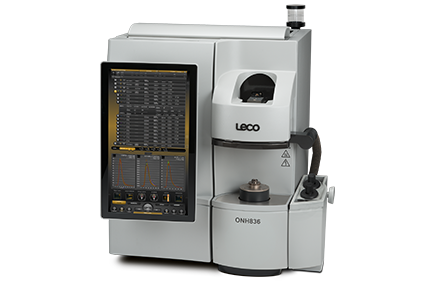
- Models
-
ONH836 Oxygen/Nitrogen/Hydrogen
-
ON836 Oxygen/Nitrogen
-
OH836 Oxygen/Hydrogen
-
O836 Oxygen
-
H836 Hydrogen
-
H836EN Hydrogen
-
N836 Nitrogen
-
NH836 Nitrogen/Hydrogen
- O836Si Oxygen for Silicon Wafers
-
- Options
-
Sample Autoloader
-
Recirculating Chiller
-
Power Purifier
-
Sound Reduction Vacuum Enclosure
-
- Featured application
Oxygen/Hydrogen in Copper and Copper Alloys - Product literature
836 Series - Consumables
RC612 Multiphase Determinator
Carbon and Water Determination
Get fast, reliable carbon and water determination with our RC612. This state-of-the-art instrument quantifies the carbon and water present in various organic and inorganic samples, and identifies the source of several types of carbon content. The RC612 has a small footprint, along with easy-to-use operating software for streamlined analysis.
- Complies with AWS (ANSI) approved method for Determination of Moisture Content of Welding Fluxes and Welding Electrode Flux Coverings
- Qualitative and quantitative analyses
- Easy-to-install combustion tube
- The large diameter reaction tube supports moisture analysis on a variety of sample types including powders, flat strips, or sections of tubes.
- Surface, Free, Organic, Inorganic carbon type differentiation
- Optional rugged 50-position autoloader for automated unattended operation
- On-board diagnostics to minimize downtime
The RC612 multiphase carbon and hydrogen/moisture determinator quantifies the carbon and water present in various organic and inorganic samples, and identifies the source of several types of carbon content.
The RC612 features a state-of-the-art furnace control system, which allows the temperature of the dual-stage furnace to be programmed from near-ambient to 1100 oC.
Depending on the application, multiple furnace steps can be programmed by the operator and the furnace purged with oxygen or nitrogen, creating oxidizing or inert conditions in which the carbon and water present is combusted or reacted. An afterburner furnace (nominally set to 850 °C) and a secondary oxidation catalyst are included in the flow path to ensure full combustion/reaction of all evolved components. Infrared detection is used to quantify the result either as a weight percentage or as a coating weight (mg/in2).
When combusted in an oxidizing atmosphere (O2), all forms of carbon (except some carbides such as SiC) are converted to CO2. In contrast, organic forms of carbon produce both H2O and CO2. Thus the presence of organic carbon may be verified by finding coincident peaks in H2O and CO2. Water and carbonate are detected when the sample is combusted in an inert (N2) atmosphere, with the furnace catalyst temperatures at 120 oC. In this mode, organic carbon is normally not detected. Additional sources of carbon can often be differentiated by the temperature at which they oxidize or volatilize.
A slow ramping temperature program, from 100 oC to 1000 oC at 20 oC/min, can be used for the analysis of unknown samples. This type of analysis can be used to indicate the temperatures at which the differing forms of carbon are oxidized, thereby enabling the operator to optimize the furnace temperature program to provide more rapid quantitative results for each form of carbon present in this sample type.
RC612 Details
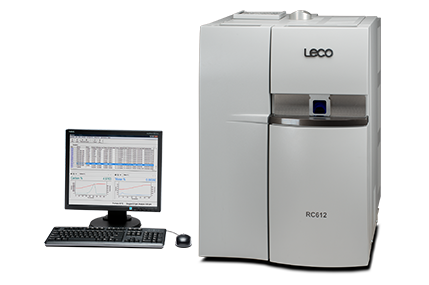
- Models
-
RC612 Multiphase Carbon and Water
-
- Options
-
Autoloader
-
- Featured application
Temperature-Dependent Determination of TOC in Soil, Rock, and Shale - Product literature
RC612 - Consumables
744 Series Combustion
Carbon and Sulfur by Combustion
Redefine the way you determine carbon and sulfur in metals, ores, and other inorganic materials with our 744 series. Using extensive customer feedback and innovative engineering, the 744 takes advantage of our immersive Cornerstone® brand software platform and a number of features, such as an improved IR cell design and available automation, come together to increase usability, lab productivity, and lower your cost-per-analysis.
Features
- High-frequency furnace
- Integrated oxygen lance floods crucible with high-purity oxygen to promote complete combustion
- 18 MHz, 2.2 kW induction furnace for rapid and consistent combustion
- Optional 10-and 60-sample autoloaders available for hours of worry-free operation
- High-velocity vacuum system keeps dust and debris contained
- Improved IR cell design
- Temperature stabilized construction provides increased protection from ambient temperature fluctuations
- Optimized emitter control and detection circuitry improves IR cell lifetime and long-term stability
Applications
The 744 series is ideal for the following applications: primary steels, ores, finished metals, ceramics, and other inorganic materials.
The CS744 carbon/sulfur analyzer is designed for wide-range measurement of carbon and sulfur content of metals, ores, ceramics, and other inorganic materials. The instrument features custom software designed specifically for touch operation.
A pre-weighed sample of approximately 1 gram is combusted in a stream of oxygen using RF induction to heat the sample. Carbon and sulfur present in the sample are oxidized to carbon dioxide (CO2) and sulfur dioxide (SO2), and swept by the oxygen carrier through a drying reagent and then through a non-dispersive infrared (NDIR) cell, where sulfur is detected as SO2. The gas flow continues past a heated catalyst, where carbon monoxide (CO) is converted to CO2 and where SO2 is converted to sulfur trioxide (SO3), which is subsequently removed by a filter. Carbon is then detected as CO2 by another NDIR cell. A pressure controller is used to maintain constant pressure in the NDIR cells so as to reduce interference from natural variations in atmospheric pressure. The final component in the flow stream is an electronic flow sensor, which is used for diagnostic purposes to monitor the carrier flow.
Non-dispersive infrared cells are based on the principle that CO2 and SO2 absorb infrared (IR) energy at unique wavelengths within the IR spectrum. Incident IR energy at these wavelengths is absorbed as the gases pass through IR absorption cells. The concentration of unknown samples is determined relative to calibration standards. To reduce interferences from instrument drift, reference measurements of pure carrier gas are made prior to each analysis.
744 Series Details

- Models
-
CS744 Carbon/Sulfur
-
C744 Carbon
-
S744 Sulfur
-
- Options
-
Boom-Mounted Touch-Screen Interface
-
Furnace Autocleaner
-
Sample Autoloader
-
Performance Packages
- Tube Furnaces
-
- Featured application
Carbon/Sulfur Determination in Low Carbon Ferroalloys - Product literature
744 Series
744 with S832 Add-On
844 Series Combustion
Carbon and Sulfur Analysis by Combustion
Easily analyze your wide-range carbon and sulfur content with our CS844 for the determination of carbon and sulfur in primary steels, ores, finished metals, ceramics, and other inorganic materials using the combustion technique. State-of-the-art hardware and our exclusive Cornerstone® touch-screen software platform provide your laboratory with increased usability and a lower cost-per-analysis.
- Maximize laboratory productivity with automation
- 10- and 60-position shuttle loaders or integrated robotic process loaders available.
- High-efficiency autocleaner/vacuum system keeps maintenance to a minimum
- Automatic combustion tube service and exchange system
- Ergonomic, operator-centered design with a boom-mounted touch-screen interface
- Improved IR cell design provides dual-range detection and improved lifetime and stability
- High-efficiency furnace with low-maintenance design reduces the need for additional accelerant and cleaning
Applications
The 844 series is ideal for the following applications: primary steels, ores, finished metals, ceramics, alloys, and other inorganic materials.
The CS844 Carbon/Sulfur system is designed for wide-range measurement of carbon and sulfur content of metals, ores, ceramics, and other inorganic materials. The instrument features custom software designed specifically for touch operation.
A pre-weighed sample of approximately 1 gram is combusted in a stream of purified oxygen using RF induction to heat the sample. Carbon and sulfur present in the sample are oxidized to carbon dioxide (CO2) and sulfur dioxide (SO2), and swept by the oxygen carrier through a heated dust filter, a drying reagent, and then through two non-dispersive infrared (NDIR) cells, where sulfur is detected as SO2. The gas flow continues past a heated catalyst, where carbon monoxide (CO) is converted to CO2 and where SO2 is converted to sulfur trioxide (SO3), which is subsequently removed by a filter. Carbon is then detected as CO2 by a second pair of NDIR cells. A pressure controller is used to maintain constant pressure in the NDIR cells so as to reduce interference from natural variations in atmospheric pressure. The final component in the flow stream is an electronic flow sensor, which is used for diagnostic purposes to monitor the carrier flow.
Non-dispersive infrared cells are based on the principle that CO2 and SO2 absorb infrared (IR) energy at unique wavelengths within the IR spectrum. Incident IR energy at these wavelengths is absorbed as the gases pass through IR absorption cells. Since absorption is dependent upon the path length, short and long path-length IR cells are provided for measurement of high and low range signals. The software automatically selects which cell to use for optimum measurement. The concentration of unknown samples is determined relative to calibration standards. To reduce interferences from instrument drift, reference measurements of pure carrier gas are made prior to each analysis.
844 Series Details
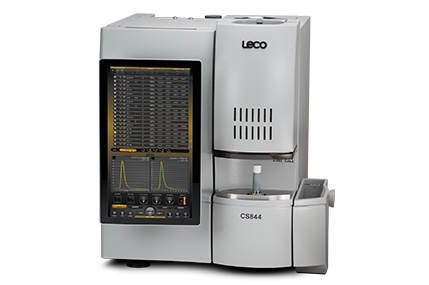
- Models
-
CS844 Carbon/Sulfur
-
C844 Carbon
-
S844 Sulfur
- CS844ES Enhanced Sulfur, Carbon
- S844ES Enhanced Sulfur
-
- Options
-
Shuttle10 Autoloader
-
Shuttle60 Autoloader
- Tube Furnaces
-
- Featured application
Carbon/Sulfur in Low Carbon Ferroalloys - Product literature
844 Series
844 with S832 Add-On - Consumables

928 Series Macro Determinator
Carbon/Nitrogen/Sulfur, and Nitrogen/Protein Analysis by Combustion
Easily handle heterogeneous, difficult to prepare, or low analyte level samples with the 928 Series Macro Determinator for determining Carbon/Nitrogen/Sulfur and Nitrogen/Protein by Combustion. State-of-the-art hardware and our exclusive Cornerstone® touch-screen software platform provide your laboratory with an increase in throughput, uptime, and reliability. Macro sample mass ability (up to 3 grams for Nitrogen/Protein model regardless of sample carbon content) with rapid cycle times and a low cost-per-analysis make the 928 Series ideal for these challenging macro samples.
- Maximize laboratory productivity with unmatched sample throughput
- Rapid cycle time of 5 minutes
- Sample mass: Up to 3.0 g for nitrogen (FP) (1.0 g nominal); up to 1.0 g for carbon/nitrogen (0.5 g nominal); up to 0.3 g for carbon/nitrogen/sulfur (0.2 g nominal)
- Optional 100-sample position autoloader for sequential and non-sequential analysis
- Ergonomic, operator-centered design with boom-mounted touch-screen interface
- Easy access to all reagent tubes and common maintenance areas for simplified maintenance
- Extended reagent lifetimes contribute to a low cost-per-analysis
- Horizontal furnace design with maximum temperatures up to 1450oC ensure complete oxidation of samples
- Expanded furnace efficiency and reliability with a regent-free design
Applications
The 928 series is ideal for the following applications: Meats, Feeds, Forage, Pet Foods, Grains, Milled Products, Starch, Fermentation Products, Dairy and Cheese Products, Soils, Sediments, Fertilizers, Plant Tissue, Filtration Media, Waste Materials, Fiber and Textiles, Resins and Polymers, Paper Products, and Petroleum Products and Additives
The 928 series determines nitrogen/protein, carbon/nitrogen, or carbon/nitrogen/sulfur in a multitude of organic matrices from foods and feeds, to soils and fertilizers. The system utilizes a high temperature horizontal ceramic combustion furnace designed to handle macro sample mass with a rapid analysis time delivering unsurpassed application capabilities and throughput.
To start an analysis, a macro-sized sample is weighed into a ceramic boat and placed in the 100-position loader. A fully automated analysis sequence transfers the sample to a sealed purge chamber, where entrained atmospheric gas is removed. The purged sample is transferred automatically to the furnace, which can be operated at temperatures from 1100 °C to 1450 °C. To ensure complete and rapid combustion (oxidation) of the sample, the furnace environment is composed of pure oxygen with a secondary oxygen flow directed to the sample via a ceramic lance. The combustion gases are swept from the furnace through a thermoelectric cooler (nitrogen/protein and carbon/nitrogen models), or an anhydrone reagent (carbon/nitrogen/sulfur model), to remove moisture, and collected in a thermostatically controlled ballast volume. The gases equilibrate and mix in the ballast before a representative aliquot of the gas is extracted and introduced into a flowing stream of inert gas for analysis. Depending upon the analyzer model, the aliquot gas is carried to a non-dispersive infrared (NDIR) cell for the detection of carbon (as carbon dioxide) and sulfur (as sulfur dioxide), and a thermal conductivity cell (TC) to detect nitrogen (N2). Unlike NDIR cells, TC cells are chemically non-specific, so a series of reagents and scrubbers are used to ensure quantitative detection of N2 without chemical interference. A heated reduction tube, filled with copper, is used to convert nitrogen oxide species (NOx) to N2 and to remove excess oxygen. Carbon dioxide (CO2) is removed by LECOSORB and water (H2O) is removed by Anhydrone.
Careful sequencing of the analysis by the Cornerstone® brand software provides maximum sample throughput by interleaving the sample loading sequence with quantitation of the aliquot gases from the previous sample. As soon as the combustion gas is collected in the ballast, and the analysis sequence is initiated for the next sample.
The determined composition of the sample is displayed by Cornerstone in weight percent or parts-per-million but can be displayed in other custom units if preferred.
Many diagnostic sensing capabilities are included in the 928 Series analyzer. Multiple Pressure Transducers (PT) to ensure the presence of sufficient oxygen and helium, and provide the ability to leak check individual segments of the flow path. Digital Mass Flow Controllers (MFC's) are used to control and measure critical flows of oxygen and helium. Thermal sensors and heaters are used to thermostatically control the temperature of critical components such as the furnace, the ballast, the dose loop, the helium MFC, the NDIR cell, and the TC cell.
928 Series Details
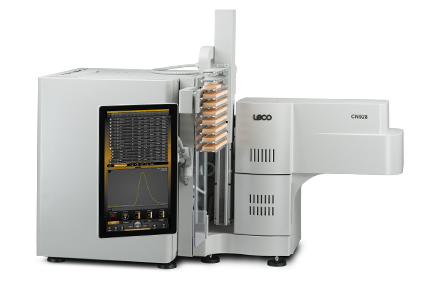
- Models
-
FP928 Nitrogen/Protein
-
CN928 Carbon/Nitrogen
- CNS928 Carbon/Nitrogen/Sulfur
-
- Options
-
Boom-Mounted Touch-Screen Interface
-
- Featured application
FP928 Nitrogen/Protein in Flour- Product literature
928 Series - Consumables
- Product literature
832 Series Combustion
Sulfur and Carbon Analysis by Combustion
LECO’s 832 series will bring productivity, precision, and progress to your lab when determining the sulfur and carbon content in a wide variety of organic materials. Our Cornerstone® brand software platform powered by a touch-screen interface, increases usability and operational control without using valuable bench space. A high-efficiency combustion furnace, improved IR cell design, and a robust, rugged design make the 832 a valuable resource for any laboratory needing fast and accurate analysis.
- An optional autoloader will streamline your lab
- 100-sample capacity autoloader with rugged design for improved reliability
- Simplifies operator workflow and delivers repeatable rapid analysis cycle times
- Improved IR cell for increased stability and precision
- Individual wide-range IR detection for both carbon and sulfur
- Improved IR cell temperature control, isolation, and circuitry
- Optional dual-range (DR) detection for sulfur for the widest sulfur range capability
- Easy to access maintenance areas
- High-efficiency furnace system design with intelligent control can reach 1550ºC
Applications
The 832 series is ideal for the following applications: Coal and Coke, Combustion Residues, Biomass Materials, Catalyst Materials, Cement, Soil and Ore Materials, Ceramics, Glass, Gypsum and Building Materials, Hydrated Lime and Cement, Fertilizer, Feeds and Plant Tissue Materials, Rubber, Resins and Polymers, Graphite, and Petroleum Products and Additives
Theory of Operation
The 832 Series of Elemental Determinators are specifically designed to determine the sulfur and carbon content in a wide variety of organic materials such as coal, coke and fuel oils, as well as some inorganic materials such as soils, cements and limestone by high temperature combustion with non-dispersive infrared detection (NDIR).
Analysis begins as a sample is weighed into a combustion boat and placed into the furnace typically regulated at 1350 oC with a pure oxygen environment. The sample combusts, releasing carbon as CO2 gas with the sulfur forms being oxidized and released as SO2 gas. After a preset time, additional oxygen is introduced via a ceramic lance directly above the sample to accelerate the combustion of refractory materials. The combustion gases are swept to the back of the furnace and then forward through the inner and outer furnace tubes, allowing the combustion gases to remain in the high temperature zone of the furnace ensuring efficient oxidation. Upon exiting the furnace, the combustion gases flow through anhydrone tubes removing moisture and on to the flow controller, setting the flow of the combustion gases through the NDIR sulfur and/or carbon detection cells.
Non-dispersive infrared cells are based on the principle that CO2 and SO2 absorb infrared (IR) energy at unique wavelengths within the IR spectrum. Incident IR energy at these wavelengths is absorbed as the gases pass through IR absorption cells with the absorption being dependent upon the path length of the cell. The Dual Range (DR) sulfur 832 model has a wider sulfur range due to a short and long path length IR cells provided for measurement of high and low range sulfur signals. The software automatically selects which cell to use for optimum measurement in the 832DR model. The concentration of unknown samples is determined relative to calibration standards.
An external PC with LECO Cornerstone brand software manages all of the quantitative calculations and saves all of the data.
832 Series Details

- Models
- S832 Sulfur
- S832DR Dual Range Sulfur
- S832HT High Temperature Dual Range Sulfur
- C832 Carbon
- SC832 Sulfur & Carbon
- SC832DR Dual Range Sulfur with Carbon
- SC832HT High Temperature Dual Range Sulfur with Carbon
- Options
-
Boom-Mounted Touch-Screen Interface
- Sample Autoloader
- Performance Packages
-
- Featured application
Sulfur in Fertilizers - Product literature
832 Series - Consumables
TruSpec® Micro
CHN / CHNS / O
The TruSpec Micro delivers optimal performance in carbon, hydrogen, nitrogen, sulfur, and oxygen determination in solid or liquid micro samples. Components work together to provide you with reliable, consistent performance marked by rapid analysis times, greater robustness/less downtime, and reduced maintenance.
Features
- Low cost-per-analysis
- Supports compliance to 21 CFR Part 11 Regulations
- Nominal sample mass of 2 mg
- Oxygen module provides independent oxygen determination capabilities with two-minute analysis time using a high-temperature (1300°C) pyrolysis furnace.
The efficiency and speed of the TruSpec Micro CHN and CHNS is a result of the unique combination of a flow-through carrier gas system used in conjunction with individual highly selective, infrared (IR) and thermal conductivity detection systems.
A weighed micro sample is placed into the autoloader of the TruSpec Micro and is automatically dropped into the high-temperature combustion furnace, allowing the sample to combust. This combustion converts carbon to CO2, hydrogen to H2O, nitrogen to N2, and sulfur to SO2. The combustion gases are swept from the furnace, through scrubbing reagents, and onto the detection systems as they are being released. Independent IR detectors are used for simultaneous detection of carbon, hydrogen, and sulfur. Nitrogen is measured using a thermal conductivity detection system. The entire analysis cycle is complete in approximately 4 minutes.
The optional micro oxygen add-on module enables the TruSpec Micro to determine oxygen content in organic matrices and is compatible with the both the TruSpec Micro CHN and CHNS models. Samples being analyzed for oxygen are placed into the autoloader of the micro oxygen add-on module and automatically dropped into a high-temperature pyrolysis furnace. The oxygen released during pyrolysis of the sample reacts with a carbon-rich environment in the furnace to form CO. The CO is swept from the furnace and converted to CO2 before measurement via infrared detector (approximately 1 minute analysis time).
TruSpec Micro Details
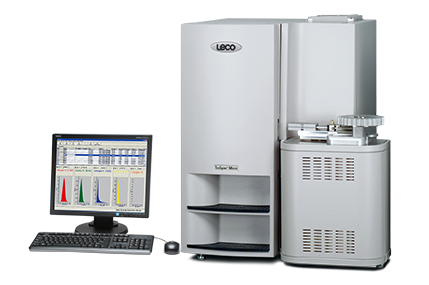
- Models
-
TruSpec Micro CHNS
- TruSpec Micro CHN
-
- Options
-
Sulfur add-on module
-
Oxygen add-on module
-
- Product literature
TruSpec Micro - Consumables
